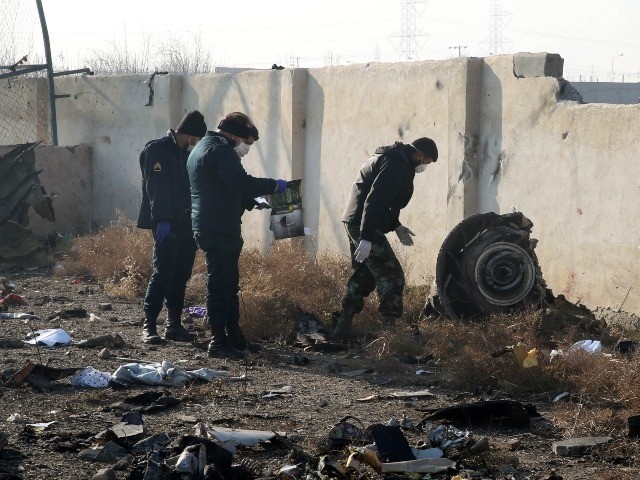The head of plane crash investigations in Iran told reporters Friday that the black boxes the nation retrieved from Ukrainian International Airlines (UIA) Flight 752, which burst into flames and crashed early Wednesday in Iran, may end up in Russia.
Russia is currently embroiled in an ongoing war, via proxies it refused to acknowledge are tied to Moscow, with Ukraine and is illegally occupying the nation’s Crimean peninsula. Russia and Iran are close allies, cooperating to help Syrian dictator Bashar al-Assad in the Syrian civil war.
Eyewitnesses and video taken at the time of the crash appears to indicate that the UIA flight burst into flames shortly after taking off from Tehran’s international airport. It crashed shortly thereafter, full of fuel for its flight to Kyiv, killing 176 people, mostly Ukrainian, Iranian, and Canadian citizens (most were to connect in Kyiv to a flight to Canada). Iranian investigators insist the evidence suggests mechanical failure, but Canadian Prime Minister Justin Trudeau and Ukrainian President Volodymyr Zelensky have both stated evidence exists suggesting that the Iranian military shot the plane down using surface-to-air missiles.
Iran has vehemently denied the accusations and reportedly demolished all evidence at the crash site before inviting investigations from the affected countries and Boeing, the manufacturer of the airplane.
During a press conference Friday to update the public on the Iranian regime’s conclusions on the crash, Ali Abedzadeh, the head of Iran’s Aviation Organization, repeated Tehran’s claim that, while first responders successfully recovered the black boxes on the flight, they are significantly damaged and not all of the footage there may be recoverable. Abedzadeh said Iran would try to retrieve the information alone but may need help from international actors.
“We need special software and hardware which are available in our country, but if we fail to extract the data due to the damages of the black box, we will get help from other countries,” he said, according to Iran’s PressTV.
Hassan Rezaeifar, the official specifically responsible for crash site investigations, listed Russia as one of the countries that may potentially receive the black boxes if Iran cannot crack them. Canada and Ukraine, the nations most affected, and France were also reportedly on the list.
Rezaeifar’s willingness to send the black boxes to allied Moscow contrasts significantly with Iran’s aggressive refusal to let Boeing inspect them.
Abedzadeh, presumably Rezaeifar’s superior, said Wednesday that Iran under no circumstances would send the boxes “to the manufacturer and the Americans.”
A preliminary Iranian investigation concluded that the flight’s demise, occurring as Iran shot over a dozen ballistic missiles at presumed American targets in Iraq and missed them all, occurred as a result of mechanical failure – the engine caught fire and pressured the crew to attempt an emergency landing, which failed. UIA has vocally rejected this theory, insisting that the plane, a Boeing 737-800, was “one of the best planes we had,” had received regular maintenance on Monday, and its crew received extra sleep and preparation for the flight.
The Ukrainian government first posited the theory that, amid attacking American targets, the Iranian military may have accidentally targeted the UIA flight.
“A strike by a missile, possibly a Tor missile system, is among the main (theories), as information has surfaced on the internet about elements of a missile being found near the site of the crash,” Oleksiy Danilov, secretary of Ukraine’s Security Council, said on Wednesday. Tor is a Russian-made missile system Tehran is known to have purchased. These missiles are different from the much larger ballistic missiles used against the U.S. targets.
By Thursday, anonymous American government sources were making similar claims in mainstream U.S. media, and that evening Trudeau asserted that he believed Iranian soldiers may have shot the plane down. He nonetheless speculated that the true blame for the deaths could fall on the United States for killing Iranian terror chief Qasem Soleimani, the act that Tehran claims it shot the ballistic missiles to avenge.
“The missile version is not being ruled out, but it is yet to be confirmed,” Zelensky told reporters on Friday.
President Donald Trump told reporters Thursday he had “suspicions” on what happened to the flight but abstained from offering theories.
If the theory holds, the fate of UIA Flight 752 will closely resemble what is believed to have happened to Malaysia Airlines Flight 17 in 2014. That plane, carrying 298 passengers of largely Dutch and Australian descent, also burst into flames and fell in eastern Ukraine, killing all on board, including 80 children. Investigations at the crash site concluded that a Russian BUK missile system was used to shoot the plane out of the sky.
“On the basis of the [Dutch-led Joint Investigation Team] conclusions, the Netherlands and Australia are now convinced that Russia is responsible for the deployment of the [Russian missile system] BUK installation that was used to down MH17,” Dutch Foreign Minister Stef Blok said in 2018. “The government is now taking the next step by formally holding Russia accountable.”
The Russian government is believed to have provided the missile system to secessionist Russian militants in the Donbas region of Eastern Ukraine. In November, new conversations between the militants and the Russian government surfaced that showed almost daily contact in which the rebels took orders from Moscow.
Those same rebels blocked investigators from accessing the crash site in the immediate aftermath of the incident.

COMMENTS
Please let us know if you're having issues with commenting.